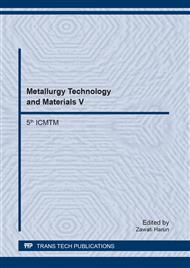[1]
H. He, H. Fuan, X. Zhu and H. Lee, Assessment on the energy flow and carbon emissions of integrated steelmaking plants, Energy Reports, Vol. 3, (2017), pp.29-36.
DOI: 10.1016/j.egyr.2017.01.001
Google Scholar
[2]
D. R. Askeland, P. P. Fulay and W. J. Wright, The science and engineering of materials, 6th edition, Cengage Learning Inc. (2011).
Google Scholar
[3]
V. Rudnev, D. Loveless, R. Cook, M. Black, Handbook of induction heating, Marcel Dekker, Inc, (2003).
Google Scholar
[4]
J. Komotori, M. Shimizu, Y. Misaka and K. Kawasaki, Fatigue strength and fracture mechanism of steel modified by super-rapid induction heating andquenching, International Journal of Fatigue, Vol. 23, (2001), pp. S225-230.
DOI: 10.1016/s0142-1123(01)00164-5
Google Scholar
[5]
B. J. Yang, A. Hattiangadi, W. Z. Li, G. F. Zhou and T. E. McGreevy, Simulation of steel microstructure evolution during induction heating, Materials science and engineering A, Vol. 527, (2010), pp.2978-2984.
DOI: 10.1016/j.msea.2010.01.038
Google Scholar
[6]
Y. Koizumi, T. Otsuka, Y. Minamino, T. Takayama, M. Ueyama, T. Daio and S. Hata, Microstructures developed by super-rapid induction heating-and-quenching (SRIHQ) of Fe–1. 4%Cr–1%C pearlitic steel, Materials Science and Engineering A, Vol. 577, (2013).
DOI: 10.1016/j.msea.2013.04.024
Google Scholar
[7]
K. Mizobe, T. Honda, H. Koike, E. C. Santos, K. Kida and T. Shibukawa, Relationship between repeatedly quenching and fisheye cracks around TiN and Al2O3 inclusions in high carbon bearing steel, Material research innovations, Vol. 18, Supply. 1, (2014).
DOI: 10.1179/1432891713z.000000000355
Google Scholar


